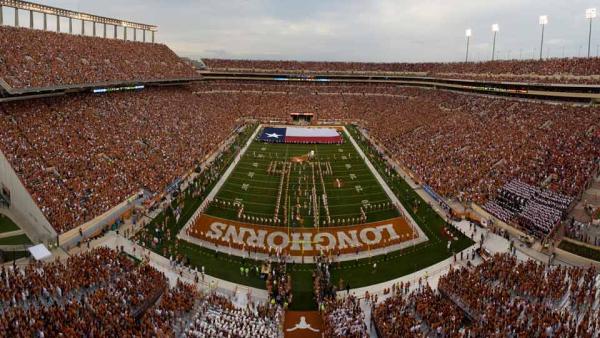Richard Cleary on Spatial Invention in Sports

By Richard Cleary, PhD
Professor and Page Southerland Page Fellow in Architecture
This is the season of tweets. Not those crawling across our screens, but the tweets we hear signaling the start of play for the fall sports of football, soccer, and volleyball. On the campus of The University of Texas at Austin, the sound draws fans to Darrell K Royal-Texas Memorial Stadium, Mike A. Myers Stadium, and Gregory Gymnasium seeking the dramatic tension of competition, the camaraderie of rooting for the Longhorns, and the potential for the unexpected. All contribute to making our appreciation of athletic contests more than the sum of wins and losses. They become aesthetic experiences grounded in spatial practices familiar to faculty and students in the School of Architecture.
With assistance from undergraduate architecture student Caroline Stacey, I’ve been thinking about how the football gridiron, the soccer pitch, and the volleyball court are sites of spatial invention. The Dutch historian Johan Huizinga recognized that play could bring “a limited perfection” to the confusion of daily life, an ambition shared by many architects. Like buildings and landscape architecture, fields of play offer settings for actions that can shape our perception, foster memories, and inspire joyful responses to creativity.
An empty stadium or arena is anticipatory, awaiting the athlete’s performance. It may also be a repository of memory and reflection. “Sports arenas are storied places. Universes of tales,” writes Michael Novak, in The Joy of Sports. A sense of history is palpable within the venerable settings of DKR—Texas Memorial Stadium, Gregory Gymnasium, and even in relatively new Mike Myers Stadium (1999). Talk in the stands is abuzz with storytelling and reminiscence.
The referee’s whistle sets the stage for new tales to unfold. At its sounding, the field of play becomes a magic circle within which the laws of the game impose particular measures of time and rules of conduct (drive blocks, for example, however effective in football, are discouraged in the barbecue line). The spell of the magic circle focuses the attention of athletes and spectators alike. From the stands, we can be transfixed by the seemingly extrasensory perception of a player “in the zone”—Vince Young seeing the slender gap allowing his sprint into the end zone to win the national championship in 2006; Kelly (Wilson) Schemdes finding space to score goals that took the soccer team deep into the NCAA playoffs in 2004; Destinee Hooker hitting thirty-four kills against Penn State in the 2009 NCAA volleyball final. When the contest is over, the bounds of the magic circle dissolve, the rules of ordinary behavior resume, and experiences become memories. Some sports ritualize this transition with post-competition handshake lines where players who’d fiercely opposed one another moments before now make an effort to acknowledge the conclusion of the game, until next time.
I view the spatial practices of sports in terms of two interrelated factors: the frame and the performance. The frame is the physical arrangement of boundaries and internal regulatory features: yard lines in football, the penalty box in soccer, and the net in volleyball. The performance is in the contest to control space by physically occupying it—the displacement of bodies by the offensive surge of a quarterback sneak, or the impenetrable barrier of a successful triple block in volleyball—and by shaping perceptions of it. Each of these sports has a history of tactical innovation intended to make opponents see the game differently. Feints lure defenders out of position. Various formations position players to make the field seemingly larger when on offense and smaller when on defense.
These spatial manipulations in sports have counterparts in the ways architects place walls and ceilings to instill a sense of compression, expansion, and direction as we move through buildings. Initially, the X's and O's on the coach’s chalkboard and the cross sections on the architect’s drawing board may be incomprehensible, but, in translation, they address a similar desire—to shape the way we see our surroundings.

